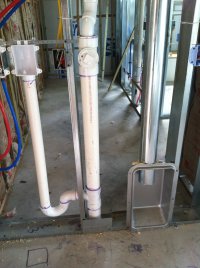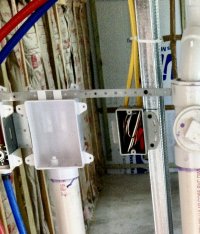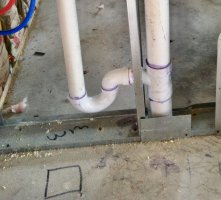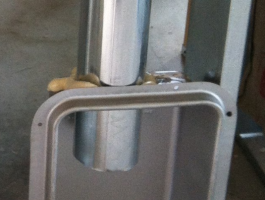-
Welcome to the new and improved Building Code Forum. We appreciate you being here and hope that you are getting the information that you need concerning all codes of the building trades. This is a free forum to the public due to the generosity of the Sawhorses, Corporate Supporters and Supporters who have upgraded their accounts. If you would like to have improved access to the forum please upgrade to Sawhorse by first logging in then clicking here: Upgrades
You are using an out of date browser. It may not display this or other websites correctly.
You should upgrade or use an alternative browser.
You should upgrade or use an alternative browser.
Clothes Washer Into 3" Stack
- Thread starter jar546
- Start date
ICE
Oh Well
wwhitney
Registered User
Definitely not an S-trap, assuming that the pipe above is a dry vent and not carrying drainage from above.Is this an S trap?
But it could be a crown vent if the trap and sanitary tee are too close together. There's supposed to be 2 pipe diameters of trap arm minimum. That's measured from the trap weir (point water crests in the trap and starts to flow out of the u-bend) to the point where the vent inside diameter intersects the trap arm.
If I'm reading Charlotte's catalog correctly, including the hubs the p-trap itself provides 1-1/4" of trap arm length, and the 3x3x2 sanitary tee provides 2-1/8" of trap arm length. So as long as the length of exposed pipe between the two hubs is at least 5/8", then it complies with the crown vent rule.
Having said all that, I'm not clear on what problem hydraulically/pneumatically a crown vent is subject to. Anyone know?
Cheers, Wayne
north star
Sawhorse
- Joined
- Oct 19, 2009
- Messages
- 4,596
# ~ #
Nail Guard missing from back side of 4" piping ?
Isn't the wall thermal insulation supposed to have
the paper fastened to the studs, rather than just
jammed up in the cavity ?
# ~ #
Nail Guard missing from back side of 4" piping ?
Isn't the wall thermal insulation supposed to have
the paper fastened to the studs, rather than just
jammed up in the cavity ?
# ~ #
steveray
SAWHORSE
Thats what I first thought...If I'm reading Charlotte's catalog correctly, including the hubs the p-trap itself provides 1-1/4" of trap arm length, and the 3x3x2 sanitary tee provides 2-1/8" of trap arm length. So as long as the length of exposed pipe between the two hubs is at least 5/8", then it complies with the crown vent rule.
And I ASSUME this is what Jeff is talking about...
406.2 Waste Connection
The waste from an automatic clothes washer shall discharge through an air break into a standpipe in accordance with Section 802.4.3 or into a laundry sink. The trap and fixture drain for an automatic clothes washer standpipe shall be not less than 2 inches (51 mm) in diameter. The fixture drain for the standpipe serving an automatic clothes washer shall connect to a 3-inch (76 mm) or larger diameter fixture branch or stack.wwhitney
Registered User
Yes, that's another question, why does the IPC requires that "The fixture drain for the standpipe serving an automatic clothes washer shall connect to a 3-inch (76 mm) or larger diameter fixture branch or stack"? The UPC has no such requirement, so it's a bit foreign to me.
Regardless, if the stack in the photo in the OP has no drainage coming down from above (which had best be the case, as otherwise the standpipe is not properly vented), then the stack could be 2", and the 2" size could be maintained until the standpipe drain joins another fixture. The definition of "fixture drain" is a drain carrying only one fixture, and the definition of "fixture branch" is a branch carrying at least two fixtures. So as long as the fixture branch is at least 3", the requirement in 406.2 is satisfied, and there's no need for the stack to be 3".
Cheers, Wayne
Regardless, if the stack in the photo in the OP has no drainage coming down from above (which had best be the case, as otherwise the standpipe is not properly vented), then the stack could be 2", and the 2" size could be maintained until the standpipe drain joins another fixture. The definition of "fixture drain" is a drain carrying only one fixture, and the definition of "fixture branch" is a branch carrying at least two fixtures. So as long as the fixture branch is at least 3", the requirement in 406.2 is satisfied, and there's no need for the stack to be 3".
Cheers, Wayne
mtlogcabin
SAWHORSE
jar546
Forum Coordinator
Boredom or ignorance?Why would you put foam at the dryer box connection?
north star
Sawhorse
- Joined
- Oct 19, 2009
- Messages
- 4,596
& = & = &
The foam "might" have been used as a quazi type adhesive
for the "pipe-to-box" connection.........Also, possibly as
some type of vibration absorber.......A 3rd possibly might be
as a decorative feature. Ha !
& = & = &
The foam "might" have been used as a quazi type adhesive
for the "pipe-to-box" connection.........Also, possibly as
some type of vibration absorber.......A 3rd possibly might be
as a decorative feature. Ha !
& = & = &
ICE
Oh Well
Why would you not?
mtlogcabin
SAWHORSE
Dryer exhaust temp can be as high as 200 degrees when operating normally. The high temperature limiting switch is usually 250 degrees. Spray foam burns at 240 degrees.
New dryers have 2 or 3 temperature limiting devices and are a lot better than older ones. Things do break or fail and I would think foam installed that close to the dryer would be a violation of the Tiger code.
New dryers have 2 or 3 temperature limiting devices and are a lot better than older ones. Things do break or fail and I would think foam installed that close to the dryer would be a violation of the Tiger code.
ICE
Oh Well
That has me wondering about dryer vent being in a wall cavity.Dryer exhaust temp can be as high as 200 degrees when operating normally. The high temperature limiting switch is usually 250 degrees. Spray foam burns at 240 degrees.
New dryers have 2 or 3 temperature limiting devices and are a lot better than older ones. Things do break or fail and I would think foam installed that close to the dryer would be a violation of the Tiger code.
steveray
SAWHORSE
If foam is lower than 451 degrees, then me too...That has me wondering about dryer vent being in a wall cavity.
mtlogcabin
SAWHORSE
6. Cured foam is combustible and will burn if exposed to temperatures above 240°F (116°C). Do not apply Great Stuff™foam around heaters, high heat lamps or recessed lighting fixtures, radiators, furnaces or fireplaces where it could contact heat conducting surfaces. Do not use Great Stuff™ foam inside electrical boxes or panels (applications around the outside of the boxes are permitted).




